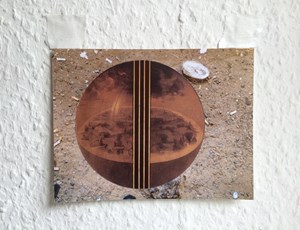
The work of Jeff Grant (b. 1975) is forthright in its perplexity. Every piece he creates centers on concealment, the ambiguous presence, forcing the viewer to engage in a search. In a way, some of his works appear distressing. They are not abstract, although shapes and objects seem blurred and disturbed. His chosen palette, black and white or colors dimmed and subtle, only emphasizes the mental haze. Portrait outlines are fuzzy and the objects from Grant's "Creation" series appear as fantastical artefacts with tortured surfaces, holding turbulent air underneath.
The work of Jeff Grant (b. 1975) is forthright in its perplexity. Every piece he creates centers on concealment, the ambiguous presence, forcing the viewer to engage in a search. In a way, some of his works appear distressing. They are not abstract, although shapes and objects seem blurred and disturbed. His chosen palette, black and white or colors dimmed and subtle, only emphasizes the mental haze. Portrait outlines are fuzzy and the objects from Grant's "Creation" series appear as fantastical artefacts with tortured surfaces, holding turbulent air underneath.
Grant takes on the role of inventor or mad scientist; experimenting with living organisms, building strange machines and constructing artificial worlds. As Grant describes it, his work "deals with ambiguities and over-determinations inherent in or applied to familiar images and forms".
In our 10 questions interview, Jeff Grant sheds light on his work and his creative process.
1) How did you know that you wanted to become an artist?
I didn't know, and I still don't, but I find excitement with my practice and have no desire to stop now.
2) How would you describe your art?
Varied, understated, serious and humorous. I use materials that make sense for the projects I work on, but also let materials inform the projects I develop. Generally I am interested in how history and memory contribute to the creative process of combining various elements into something recognizable, understandable, or relatable.
3) Is it hard to be an artist?
It can be.
Jeff Grant, Bosch 58. The Creation, 2011. Book page and sandpaper on paper. 33 x 20.3 cm. Courtesy of the artist and LMAKgallery, NYC
Jeff Grant, Creation sandpit, 2016. Book page fragment on archival inkjet print. 11.1 x 14.5 cm. Courtesy of the artist and LMAKgallery, NYC
4) What is your greatest achievement so far?
Maintaining an enthusiasm in making my work, and an interest in the work itself.
5) Which contemporary artists do you follow?
Bruce Nauman, Chantal Akerman, Roni Horn, Richard Tuttle, Gabriel Orozco, Béla Tarr, Claire Denis, to name a few.
6) What do you do when you are not happy with the result?
I keep working until I find the result adequately compelling, or I put the work away and see if I can reuse the materials for another work. Sometimes I throw things away.
7) Do you need to explain your art?
I find it better if the art is not explained before it is viewed. After that, my work should not be explained to any great length. Explanation usually damages the work in my experience.
8) Do you want to try something else in the future?
I always try other things, and will keep doing so.
Jeff Grant, Left: Buddy, Right: Pal, both 2016. Each: Graphite and colored pencil on paper. Each: 61 x 45.8 cm. Courtesy of the artist and LMAKgallery, NYC
Misery.
10) What is your ultimate dream?
I don't know.

ArtDependence Magazine is an international magazine covering all spheres of contemporary art, as well as modern and classical art.
ArtDependence features the latest art news, highlighting interviews with today’s most influential artists, galleries, curators, collectors, fair directors and individuals at the axis of the arts.
The magazine also covers series of articles and reviews on critical art events, new publications and other foremost happenings in the art world.
If you would like to submit events or editorial content to ArtDependence Magazine, please feel free to reach the magazine via the contact page.